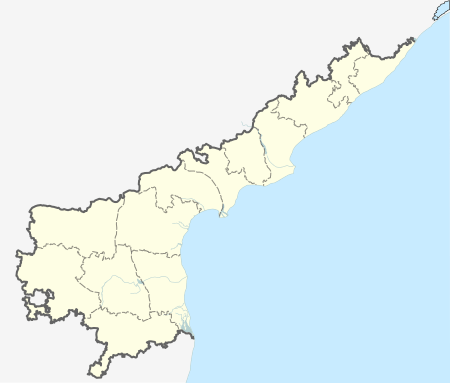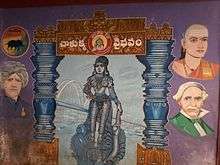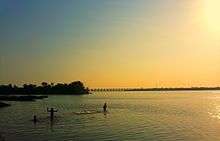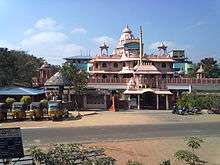Rajahmundry
| Rajahmundry రాజమండ్రి | |
|---|---|
| City | |
| Rajamahendravaram | |
|
A train moving inside Rail cum Road Bridge | |
| Nickname(s): Cultural Capital of Andhra Pradesh[1] | |
 Rajahmundry Location of Rajahmundry in Andhra Pradesh | |
| Coordinates: 16°59′N 81°47′E / 16.98°N 81.78°ECoordinates: 16°59′N 81°47′E / 16.98°N 81.78°E | |
| Country | India |
| State | Andhra Pradesh |
| Region | Coastal Andhra |
| District | East Godavari |
| Founded by | Rajaraja Narendra (king 1022 AD) |
| Government | |
| • Body | Rajahmundry Municipal Corporation |
| Area | |
| • City | 44.50 km2 (17.18 sq mi) |
| Area rank | 4 |
| Elevation | 14 m (46 ft) |
| Population (2011)[2] | |
| • City | 341,831 |
| • Rank |
108th (India) 6th (Andhra Pradesh) |
| • Metro[3] | 476,873 |
| Languages | |
| • Official | Telugu |
| Time zone | IST (UTC+5:30) |
| PIN | 533 XXX |
| Telephone code | +91-883-XXX XXXX |
| Vehicle registration | AP-05 |
| Website |
rajahmundry |
Rajahmundry (officially: Rajamahendravaram) is one of the major cities in the Indian state of Andhra Pradesh. It is located on the banks of the Godavari River, in East Godavari district of the state. The city is the mandal headquarters to both Rajahmundry (rural) and Rajahmundry (urban) mandals. It is also the divisional headquarters of Rajahmundry revenue division and one of the two municipal corporations in the district, alongside Kakinada.[4] As of 2011 census, it is the sixth most populous city in the state, with a population of 341,831.[5]
The city is most notable for its historic agricultural, economic and cultural backgrounds. Hence, the city is also known as the Cultural Capital of Andhra Pradesh.[1] One of the longest road cum rail bridges is on the Godavari River, connecting Kovvur and Rajahmundry.[6]
Etymology
In its earlier days, it was called Rajamahendravaram.[1] But later, it was referred as Rajahmundry. On 10 October 2015, the government made the official announcement to rename the city with its original name, Rajamahendravaram.[7]
History

The city can be traced back to the rule of the Eastern Chalukya king Raja Raja Narendra who reigned around 1022 AD, after whom it is named – Rajamahendri or Rajamahendravaram. Remains of 11th century palaces and forts still exist. However, new archaeological evidence suggests that the town may have existed much before the Chalukyas.
Rajahmundry was established by Ammaraja Vishnuvardhana the First (919–934 AD). Some people believe in this theory as Vishnuvardhana had the title "Rajamahendra". His predecessor Ammaraja Vijayaditya the Second (945–970 AD) also had the same title, "Rajamahendra".
Ruler timeline:
- Raja Raja Narendra (1020–1061 AD)
- Kakatiya Rule (1323 AD)
- Reddy and Gajapathi (1353–1448 AD)
- Vijayanagar
- Nizam
- Anglo – French (1758 AD)[8]
In the Madras Presidency, the district of Rajahmundry was created in 1823. The Rajahmundry district was reorganised in 1859, bifurcated into the Godavari and Krishna districts. During British rule, Rajahmundry was the headquarters of Godavari district. Godavari district was further bifurcated into East and West Godavari districts in 1925. Rajamahendravaram was renamed Rajahmundry during the rule of the British, for whom the city was the headquarters of the Godavari district. When the district was split into East and West, Kakinada became the headquarters of East Godavari.
Rajahmundry is acclaimed as the birthplace of the Telugu language — its grammar and script evolving from the pen of the city-born poet, Nannayya. Also known as 'Adi Kavi' (the first poet) of Telugu, Nannayya, along with Tikkana and Yerrana, translated the Sanskrit version of Mahabharata into Telugu. Kandukuri Veeresalingam — a social reformer and the author of Rajashekhara Charithra, the first Telugu novel — was also from Rajahmundry.
Rajahmundry was one of the biggest cities in South India in the 19th century. It was the hotbed of several movements during India's freedom struggle and acted as a base for many key leaders. When the Indian National Congress had its first meeting in Bombay (Mumbai), two leaders from Rajahmundry, Nyapathi Subba Rao and Kandukuri Veeresalingam participated in it. Subba Rao, founder of Hindu Samaj in Rajahmundry, was also one of the six founders of India's noted English daily, The Hindu.
The rebirth of culture in Andhra Pradesh started in Rajahmundry. Kandukuri Veeresalingam Pantulu is known as the father of reforms in Andhra Pradesh. He started a monthly magazine, Vivekavardhini, a school for girls at Dowleswaram in 1874. The first widow remarriage took place on 11 December 1881. A society with 16 members was started on 22 Jun 1884, which used to look after widow remarriages in Rajahmundry. The town hall in Rajahmundry was established in 1890 by Veeresalingam.
Annie Besant visited Rajahmundry twice. First, she came when the foundation of a branch of the Divya Gyan Samaj building at Alcot Gardens was being laid. She came again during the opening ceremony of the building.
Ramakrishna Mission was established in 1950–51 near Kambal tank. The place is now the Ayakar Bhavan (Income Tax Office).
Independence movement and Rajahmundry: (1885–1905 AD)
Vande Mataram Movement was started in the year 1905 against the partition of Bengal. Bipin Chandra Paul visited Rajahmundry in April 1905 for the same. During his visits to Rajahmundry, he used to address the public in "Paul Chowk" (the present-day Kotipalli Bus Stand).
Fort Gate (Kotagummam)
The area comprising the Old Godavari Railway Station, the statue of Mrityunjaya (Lord Siva), the statue of Potti Sriramulu and Hotel Ajanta is called Fort Gate. Today, the Fort Gate is not there, but a wall (only a part) covering the main street (through which elephants, horses etc. were taken for a bath) is found. This wall is slanted on both sides.
During the construction of the Havelock Bridge (named after the then Madras Governor) in 1900, one of the fort walls was demolished. The fort was constructed between the 8th and 11th centuries during the reign of the Chalukyas. Even today, we see the Kandakam Street (Kandakam – moat or a big canal dug around a fort and filled with water to stop the enemy entering – generally 20 feet (6.1 m) deep and 50 feet (15 m) wide).
The present municipal water works department (formerly Municipal High School) was famous as Ratnangi and Chitrangi palaces and was an underground escape route (Surangamu or way to escape when enemy forces attack the palace from all the sides).
The fort of the Dutch
Rajahmundry was under Dutch rule for some time. In 1602, the Dutch constructed a fort here. In 1857, the British conquered the Dutch. They converted it into a jail in 1864 and, then, elevated it to a central jail in 1870. The jail is spread over 196 acres (79 ha) out of which the buildings occupy 37.24 acres (15.07 ha).
Geography
Rajahmundry is located at 16°59′N 81°47′E / 16.98°N 81.78°E.[9] with an average elevation of 14 metres (46 ft). There is paddy and sugarcane cultivation in the area. River Godavari flows through the west of Rajahmundry.
The Rajahmundry traps, part of the Deccan Traps, are located on the Godavari river and are of particular interest to geologists.[10]
Climate
The weather is hot and humid, with a tropical climate and, thereby, no distinct seasons. The mean maximum temperature is 32 °C. The hottest season is from April to June, with temperature ranging from 34 °C to 48 °C with maximum of 51 °C recorded in May 2002 and May 2007. The coolest months are December and January, when it is pleasant at 27 °C to 30 °C. There is heavy monsoon rain at the end of summer, with depressions in the Bay of Bengal.
| Climate data for Rajahmundry | |||||||||||||
|---|---|---|---|---|---|---|---|---|---|---|---|---|---|
| Month | Jan | Feb | Mar | Apr | May | Jun | Jul | Aug | Sep | Oct | Nov | Dec | Year |
| Average high °C (°F) | 28 (82) |
30.7 (87.3) |
33.8 (92.8) |
36 (97) |
37.8 (100) |
36.3 (97.3) |
32.1 (89.8) |
31.9 (89.4) |
32 (90) |
31.2 (88.2) |
28.9 (84) |
27.9 (82.2) |
32.22 (90) |
| Average low °C (°F) | 18.5 (65.3) |
20.5 (68.9) |
22.6 (72.7) |
25.9 (78.6) |
27.8 (82) |
27 (81) |
25.3 (77.5) |
25.3 (77.5) |
25.3 (77.5) |
24.2 (75.6) |
21.5 (70.7) |
18.5 (65.3) |
23.53 (74.38) |
| Average precipitation mm (inches) | 3 (0.12) |
6 (0.24) |
11 (0.43) |
21 (0.83) |
67 (2.64) |
142 (5.59) |
260 (10.24) |
187 (7.36) |
177 (6.97) |
197 (7.76) |
37 (1.46) |
7 (0.28) |
1,115 (43.92) |
| Source: en.climate-data.org | |||||||||||||
Demographics
| Historical population | ||
|---|---|---|
| Year | Pop. | ±% |
| 1871 | 19,738 | — |
| 1881 | 24,555 | +24.4% |
| 1891 | 28,397 | +15.6% |
| 1901 | 36,408 | +28.2% |
| 1911 | 48,417 | +33.0% |
| 1921 | — | |
| 1931 | — | |
| 1941 | — | |
| 1951 | 105,276 | — |
| 1961 | — | |
| 1971 | 189,000 | — |
| 1981 | 267,749 | +41.7% |
| 1991 | — | |
| 2001 | 315,251 | — |
| 2011 | 341,831 | +8.4% |
As of 2011 Census of India, the city had a population of 341,831. The total population constitute 169,786 males and 174,117 females — a sex ratio of 1026 females per 1000 males, higher than the national average of 940 per 1000.[11][12] 29,883 children are in the age group of 0–6 years, of which 15,152 are boys and 14,731 are girls—a ratio of 972 per 1000. The average literacy rate stands at 84.28% (male 88.14%; female 80.54%) with 264,653 literates, significantly higher than the national average of 73.00%.[11][13]
The urban agglomeration had a population of 478,199, of which males constitute 236,489, females constitute 241,710 —a sex ratio of 1022 females per 1000 males and 42,968 children are in the age group of 0–6 years. There are a total of 359,051 literates with an average literacy rate of 82.50%.[3]
Governance
Rajahmundry Municipal Corporation is spread over an area of 44.50 km2 (17.18 sq mi) with 50 wards.[2][14] On 18 March 2013, 21 panchayats were included in the Rajahmundry corporation, which includes, Bommuru, Burugupudi, Chakradwarabandham, Dowleswaram, Gadala, Hukumpeta, Katheru, Kolamuru, ,Lalacheruvu, Madhurapudi, Namavaram, Narendrapuram, Nidigatla, Palacherla, Pidimgoyyi, Rajanagaram, Rajavolu, Satellite city, Thorredu, Velugubanda, Venkatanagaram.[15][16]
The Mayor of the corporation is Pantam Rajini Sesha Sai and the commissioner is Vijay Rama Raju.V.[17][18]
Infrastructure
Bridges
Godavari Arch Bridge
The bridge, built by the Hindustan Construction Company for the Indian Railways, was designed by Bureau BBR, Switzerland and checked by Leonard Andrea and Partners, Germany.[19][20] Construction on the bridge began in 1991 and lasted till 1997. It was commissioned for passenger traffic in March 1997 and became fully operational for running trains by the Indian Railways from 2003.[6]

Old Godavari Bridge
The construction of the bridge commenced on 11 November 1897 and opened for traffic on 30 August 1900. The bridge was named after Sir Arthur Elibank Havelock, the then Governor of Madras. Frederick Thomas Granville Walton served as the Engineer-in-Chief, assisted by executive engineers R A Delanougerede, F D Couchman and J E Eaglesome.[21] It has 56 spans, each of 45.7 metres (150 ft) and is 2,754 metres (9,035 ft) long. Having served its full life span of 100 years, it was decommissioned in 1997, and Godavari Arch Bridge was built as a replacement.[6]
Road Cum Railway Bridge
This Rail Cum Road Bridge is the longest of its kind in Asia and the second longest in the world. Its total length is 4.732 km (4732 mts). Finished in 1972 and inaugurated by the then President of India, Fakruddin Ali Ahmed, its construction cost accrued to INR 630 million. Locally, it is called Kovvur bridge by the people of Rajahmundry, as it connects Rajahmundry city with Kovvur town. It is also important in connecting the agriculturally rich East and West Godavari Districts with each other.[6]
Transport

Roadways
Rajahmundry is well connected to all parts of the state. NH-5 passes through Rajahmundry providing road connectivity to all major cities and towns. The city has a total road length of 472.28 km.[22] The Andhra Pradesh State Road Transport Corporation operates bus services from Rajahmundry bus station.[23]
Railways
Rajahmundry is an A–category station in the Vijayawada railway division.[24] It is located on the Howrah-Chennai main line of South Central Railway zone.
Waterways
National Waterway 4 was declared on 24 November 2008, which connects the Indian states of Telangana, Andhra Pradesh, Tamil Nadu, and the union territory of Puducherry. It passes through Kakinada, Eluru, Commanur, Buckingham Canal and also part of Krishna and Godavari rivers rivers.[25] It is being developed by Inland Waterways Authority of India, and is scheduled for completion in 2013.[26]

Airways
Rajahmundry Airport, situated near Madhurapudi 18 km away from the heart of the city. Jet Airways, Spicejet, and TruJet are major airliners. A new terminal building was inaugurated on 16 May 2012. Runway is being expanded from the 1,749 m to 3,000 m to facilitate the landing and takeoff of bigger aircraft.[27]
Tourism




The river Godavari and its bridges, Sir Arthur Cotton museum etc. are some of the attractions in the city. Rajahmundry is a major Hindu pilgrimage sites, with a number of temples. It hosts holy congregations called Pushkaram held once every 12 years and considered auspicious to take sin-ridding holy dips—with the last in July 2015, when around 100 millions are said to have taken the bath. Krishna temple constructed by the ISKCON foundation on the banks of Godavari.[28] Popularly called as Gowthami Ghat, it is a major attraction for young people as a recreational centre.
Sir Arthur Cotton Museum in Dowleswaram (beside barrage) is the only museum for Civil engineering in the state. The Museum houses several rare photographs of Sir Arthur Cotton and of the construction of the dam. The tools used to construct the dam are still preserved here. The Dowleswaram Barrage is an irrigation structure which is built on the lower stretch of the Godavari River before it empties into the Bay of Bengal.
Economy
Rajahmundry is a commercial hub for east and west Godavari districts. It is a well-known destination for cloth and bullion business. Cloth market in the city is one of the largest markets in India with many co-operative handloom houses. Rajahmundry is home for many cloth merchants.
Rajahmundry is one of the largest bullion markets in India which consists hundreds of gold, silver and platinum shops throughout the city. Important business locations are the Mahatma Gandhi Wholesale Cloth Market (MGC) complex, Thadithota), Mainroad (Fortgate) Market and Devi Chowk.
Culture
Durga Cinetone was the first south Indian film studio, to be built in Rajahmundry in the year 1936 by Nidamarthi Surayya.[29]
Art and crafts
Damerla Rama Rao Art Gallery of the city has various paintings such as, Krishna Leela, Godavari of Eastern Ghats and Milkmaids of Kathiawar etc.[30]
Education
The city plays a major role in education for the rural students of the nearby villages.The primary and secondary school education is imparted by government, aided and private schools, under the School Education Department of the state.[31] As per the school information report for the academic year 2015–16, the city limits (including the merged villages) have more than 54,143 students enrolled in over 228 schools.[32][33]
The Central Board of Secondary Education, Secondary School Certificate or the Indian Certificate of Secondary Education are the different types of syllabus followed by different schools. The medium of instruction followed by schools are English, Telugu and Urdu.
The Government Arts College, in Rajahmundry was founded more than 150 years ago and is a NAAC accredited (A) Institution. The institutes founded by the great reformer Kandukuri Veeresalingam Panthulu have now grown into large colleges and organisations. SKR Women's college is famous for its campus and teaching facilities. The BEd Training Institute is one of the oldest in India. St. Ann's (EM) School, APPM Model High School, Bala Vigjana Mandir (B.V.M.), Sri Satya Sai Gurukulam, etc. being among the better known schools.
Adikavi Nannaya University is established in March 2006 through the Government of Andhra Pradesh Act No. 28 of 2006 at Rajahmundry. Named after an 11th-century poet Nannayabhatta, who is revered as Adikavi (the first poet) of Telugu literature. Other major universities in the city include Sri Potti Sri Ramulu Telugu University, Acharya NG Ranga Agricultural University, Dr. B.R. Ambedkar Open University Study Center (govt. college).
Godavari Institute of Engineering and Technology was established in 1998 to offer engineering education of world-class standards. BVC Educational Society which was registered on 8 July 1992 under the district registrar, East Godavari District, Andhra Pradesh. GSL Medical College Rajahmundry Established in 2002 under the aegis of GSL Educational Society, GSL Medical College is one of the top private medical institutions in India. There is also a Godavari Chapter of Institute of Cost and Works Accountants of India for those aspiring to have cost and works accountancy as their profession, which provides regular coaching for the ICWA courses since 1993.
Law colleges include GSKM Law College, Veeravalli College of Law, Telugu University, G.M.R. Polytechnic College, Andhra Kesari Junior & Degree College, Government Jr College. Rajahmundry has many more educational institutions and colleges, as well as numbers of schools.
Notable people
- Sri Nannayya, (c. 11th century AD) is the earliest known Telugu author, and the author of the first third of the Andhra Mahabharatamu, a Telugu retelling of the Mahabharata.
- Sri Rajaraja Narendra, (1019–1061) was the Eastern Chalukya king of the Vengi kingdom in South India. Rajaraja was related to the Cholas of Tanjavur by marital and political links. Rajaraja Narendra established the city Rajahmahendravaram (Rajamundry).
- Sri Kandukuri Veeresalingam (1848–1919), a renowned social reformer, is widely considered as the man who first brought about a renaissance in the Telugu people and Telugu literature; he is also known to have helped women come out of their closets.
- General Sir Arthur Thomas Cotton, (15 May 1803 – 24 July 1899) was a British general and irrigation engineer.
- Sri Adurthi Subba Rao, Prominent Old-time Director & Producer of Telugu & Hindi Films.
- Julia Maitland, a campaigner for "native" education, founded a multilingual school and reading room in the town in 1837.[34]
- Jaya Prada, a popular actress of Telugu & Hindi film industry has entered politics and got elected as Member of Parliament from Rampur constituency of Uttar Pradesh as a Samajwadi Party.
- Julia Jacobs Harpster (1846-1935), American Lutheran missionary worked with Indian women at Rajahmundry, 1893-1909.
Film industry
- Ali, Tollywood Actor, Comedian
- Raja Babu, Tollywood Actor, Comedian
- Jaya Prada, Indian Actress
- Durgabai Deshmukh: (Freedom fighter, lawyer, social worker and politician)
- Sameera Reddy, Bollywood actress
- Sriman, actor
- Meghna Reddy, Indian Model and VJ for [channel V]
- Rasool Ellore, Bollywood and Hollywood cameraman
- Thotakura Venkata Raju, (Music director, singer)
- Tanguturi Suryakumari, actor,[35] Classical Singer and Dancer, First Miss Madras,[36] and evangelist of yoga and Indian dance in US[37]
- Uma Pemmaraju, Television anchor, US
- Ramesh, actor
- J. D. Chakravarthy Tollywood/Bollywood actor
- Dronamraju Chinna Kameswara Rao (FilmoGraphy Director),[38]
See also
- List of cities in Andhra Pradesh by population
- List of cities in Andhra Pradesh by area
- List of municipal corporations in Andhra Pradesh
References
- 1 2 3 "Introductory". Rajahmundry Municipal Corporation. Retrieved 3 September 2014.
- 1 2 "Municipalities, Municipal Corporations & UDAs" (PDF). Directorate of Town and Country Planning. Government of Andhra Pradesh. Retrieved 23 June 2016.
- 1 2 "Agglomerations and Cities". citypopulation.de.
- ↑ "Krishna District Mandals" (PDF). Census of India. pp. 365–366,409. Retrieved 21 January 2015.
- ↑ "Andhra Pradesh (India): Districts, Cities, Towns and Outgrowth Wards - Population Statistics in Maps and Charts".
- 1 2 3 4 Bhandari, R.R. "Bridges: The Spectacular Feat of Indian Engineering" (PDF). Indian Railway Service of Mechanical Engineers. National Informatics Centre. pp. 11–12. Retrieved 26 June 2015.
- ↑ "Rajahmundry in AP renamed as Rajahmahendravaram – The Times of India". timesofindia.indiatimes.com. Retrieved 23 October 2015.
- ↑ "1000+ Years History (Since 919 AD)". History of Rajahmundry. Rajahmundry.net. Archived from the original on 14 October 2008. Retrieved 22 October 2008.
- ↑ "Maps, Weather, and Airports for Rajahmundry, India". fallingrain.com.
- ↑ Ajoy K Baksi. "Rajahmundry Traps: Deccan traps" (PDF). The Rajahmundry Traps, Andhra Pradesh: Evaluation of their petrogenesis relative to the Deccan Traps. Indian Academy of Science. Retrieved 23 October 2008.
- 1 2 "22 villages may be included in Rajahmundry soon". The New Indian Express. Rajahmundry. 11 February 2013. Retrieved 14 August 2015.
- ↑ "Sex Ratio". The Registrar General & Census Commissioner, India. Retrieved 3 September 2014.
- ↑ "Chapter–3 (Literates and Literacy rate)" (PDF). Registrar General and Census Commissioner of India. Retrieved 3 September 2014.
- ↑ "District Census Handbook – East Godavari" (PDF). Census of India. p. 3,16–17. Archived from the original (PDF) on 13 November 2015. Retrieved 6 November 2015.
- ↑ BVS Bhaskar (20 March 2013). "21 gram panchayats merged into RMC". The Hindu. Rajahmundry. Retrieved 24 August 2015.
- ↑ "Rajahmundry Municipal Corporation Enlarged with 21 Gram Panchayats". Tgnns. Retrieved 24 August 2015.
- ↑ "Mayor Profile". Rajahmundry Corporation. Retrieved 21 July 2015.
- ↑ "Commissioner Profile". Rajahmundry Corporation. Retrieved 21 July 2015.
- ↑ "Godavari Bridge". Structurae. Retrieved 7 June 2011.
- ↑ Sinha, A. K. (2000). "Technical Paper on Design Aspects of the Third Railway Bridge Across Godavari at Rajahmundry". In Dayaratnam, P. Cable Stayed, Supported, and Suspension Bridges. Hyderabad, India: Universities Press. p. 219. ISBN 978-81-7371-271-5.
- ↑ Khan, Mukram. "The Havelock Bridge Meorial Stone | Flickr – Photo Sharing!". Flickr. Retrieved 30 July 2012.
- ↑ "DETAILS OF ROADS IN EACH ULB OF ANDHRA PRADESH". Archived from the original on 1 August 2016.
- ↑ "Bus Stations in Districts". Andhra Pradesh State Road Transport Corporation. Archived from the original on 22 March 2016. Retrieved 9 March 2016.
- ↑ "Divisional info" (PDF). Indian Railways. Archived from the original (PDF) on 28 January 2016. Retrieved 10 February 2016.
- ↑ Ministry of Shipping (Government of India). "National waterways Declaration". Retrieved 5 August 2010.
- ↑ Press Information Bureau, Government of India (2 August 2010). "Development Authority for Inland Waterways in India". Retrieved 5 August 2010.
- ↑ "Rajahmundry airport terminal operational". The Hindu Business Line. 17 May 2012. Retrieved 24 June 2014.
- ↑ "Iskcon Jagad Guru Bhaktivedanta Srila Prabhupada Chanting Books Lectures Quotes Lilamrita Photos". Iskconrajahmundry.com. Retrieved 30 July 2012.
- ↑ Ram, P (2014). Life in India. AnVi. p. 153. Retrieved 2 July 2016.
- ↑ "Damerla Rama Rao Art Gallery: a picture of neglect". The Hindu. 11 August 2015. Retrieved 2 July 2016.
- ↑ "School Education Department" (PDF). School Education Department, Government of Andhra Pradesh. Retrieved 13 November 2016.
- ↑ "School Information Report".
- ↑ "Student Information Report". Commissionerate of School Education. Child info 2015-16, District School Education - Andhra Pradesh. Retrieved 13 November 2016.
- ↑ Letters from Madras, during the years 1836–1839, by a Lady (London, 1843).
- ↑ "Tanguturi Suryakumari". IMDb.
- ↑ "Friday Review Hyderabad / Tribute : Twinkle toes and a magical voice". Chennai, India: The Hindu. 4 July 2008. Retrieved 16 June 2012.
- ↑ Harpe, Bill (18 May 2005). "Surya Kumari". The Guardian. London. Retrieved 22 May 2010.
- ↑ "Mahananda (1939)". IMDb.
- ↑ "Kacha Devayani (1938)". IMDb.
External links
| Wikimedia Commons has media related to Rajahmundry. |
| Wikivoyage has a travel guide for Rajahmundry. |

